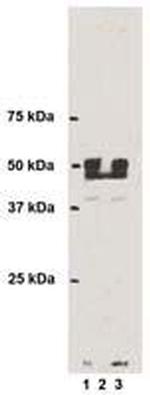Search Thermo Fisher Scientific
Product Details
MA1-12770
Species Reactivity
Host/Isotype
Class
Type
Clone
Immunogen
Conjugate
Form
Concentration
Purification
Storage buffer
Contains
Storage conditions
Shipping conditions
RRID
Target Information
Protein tyrosine nitration results in a post-translational modification that is increasingly receiving attention as an important component of nitric oxidesignaling. While multiple nonenzymatic mechanisms are known to be capable of producing nitrated tyrosine residues, most tyrosine nitration events involve catalysis by metalloproteins such as myeloperoxidase, eosinophilperoxidase, myoglobin, the cytochrome P-450s, superoxide dismutase and prostacyclin synthase. Various studies have shown that protein tyrosinenitration is limited to specific proteins and that the process is selective. For example, exposure of human surfactant protein A (SP-A) to oxygen-nitrogen intermediates generated by activated alveolar macrophages resulted in specific nitration of SP-A at tyrosines 164 and 166, while addition of 1.2 mMCO 2 resulted in additional nitration at tyrosine 161. The presence of nitrotyrosine-containing proteins has shown high correlation to disease states such as atherosclerosis, Alzheimer’s disease, Parkinson’s disease and amyotrophic lateral sclerosis.
For Research Use Only. Not for use in diagnostic procedures. Not for resale without express authorization.
References (0)
Bioinformatics
Protein Aliases: 3-Nitro-tyrosine; C9H10N2O5

Performance Guarantee
If an Invitrogen™ antibody doesn't perform as described on our website or datasheet,we'll replace the product at no cost to you, or provide you with a credit for a future purchase.*
Learn more
We're here to help
Get expert recommendations for common problems or connect directly with an on staff expert for technical assistance related to applications, equipment and general product use.
Contact tech support

